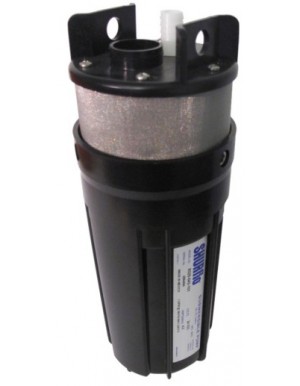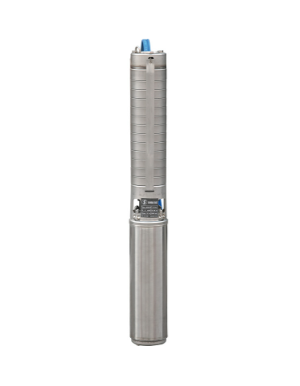Solar Pump Submersible Shurflo 12/24V
Solar submersible pump of the Shurflo 9300 series with 24V operating voltage.
The Shurflo 9325 submersible pump is a high quality, easy to operate and maintain water pump recommended for small-scale installations such as livestock watering troughs, irrigation systems or drinking water supply systems. With a motor capable of operating at 12 and 24 V DC, this immersion pump can be powered by batteries or directly connected to photovoltaic modules.
The pump is designed for solar energy applications due to its low power consumption.
The 9300 series has more than 45 years of research behind it, making it a simple, reliable and safe product. It is designed to be both lightweight and rugged. It comes with a 1 year warranty.
Submersible well pump SACI
This submersible well pump is the SACI model SP 70-25 T, whose basic specifications are:
- Voltage: 3x230V
- Power: 10 HP
- Electrical power: 7500W
- Current: 18,4A
This submersible pump is designed for use in wells and provides an efficient flow of water. It is a high hydraulic performance pump, especially suitable for lifting, distribution and pressurisation in civil and industrial hydraulic installations. in civil and industrial hydraulic installations. Installation in pressure equipment, cisterns, irrigation and washing systems, etc. irrigation systems, washing systems, etc. ....
More about solar pumps
Solar pumping refers to the use of solar energy to pump water or other liquids using solar pumping systems. These systems harness the sun's energy to provide the power needed to pump the liquid.
There are different types of solar pumping systems, but one of the most common is the solar water pumping system. This system consists of solar photovoltaic panels that capture solar energy and convert it into electricity. This electricity is used to power a water pump that draws the liquid from a source, such as a well, river or pond, and transports it through pipes to its destination, such as a storage tank or irrigation system.
Solar pumping offers several advantages. First, it uses a clean, renewable energy source, reducing dependence on fossil fuels and contributing to climate change mitigation. In addition, because it does not require connection to the grid, it is especially useful in remote or rural areas where access to electricity may be limited or expensive.
Solar pumping can also be more economical in the long term, as operating costs are low once the initial investments in the system have been made. In addition, it requires less maintenance than conventional pumping systems.
Solar pumping is used in a wide range of applications, including agricultural irrigation, drinking water supply, livestock, household and community water systems, remote area water systems and development projects in developing countries.
In short, solar pumping is an efficient, sustainable and cost-effective way of pumping water using the sun's energy. Its application can have a significant impact on access to clean water and agricultural productivity, as well as reducing the carbon footprint and caring for the environment.
A typical solar pump consists of the following components:
- - Solar panels: These are responsible for capturing solar energy and converting it into electrical energy. These panels are usually made of photovoltaic cells that generate electricity when exposed to sunlight.
- - Charge controller: This device regulates the amount of energy that is sent from the solar panels to the pump. It helps protect the system from overcharging or deep discharging the battery, which can affect the life of the system.
- - Battery: Some solar pumps include a battery to store excess energy generated by the solar panels during the day. This allows the pump to operate even on cloudy days or at night when there is not enough sunlight available.
- - Pump motor: The motor is the main component of the pump and is responsible for driving the water or fluid. It can be a direct current (DC) electric motor or an alternating current (AC) motor, depending on the design of the pump.
- - Piping and fittings: These elements connect the pump to the well, pond or other water source, and also distribute the water to where it is required. Different types of pipes and fittings are used depending on the specific needs of the system.


